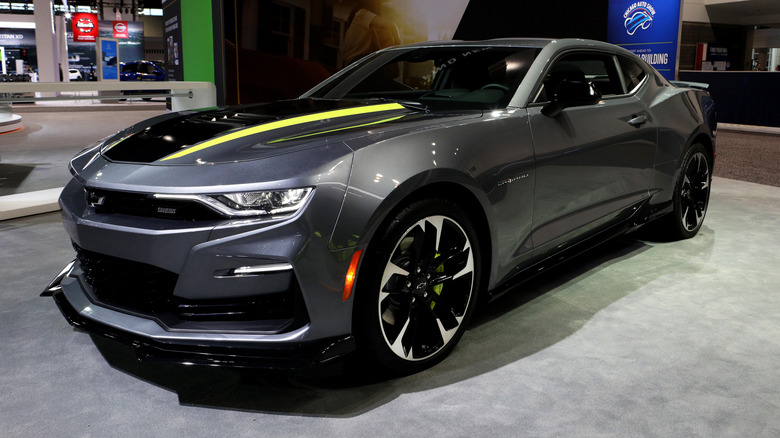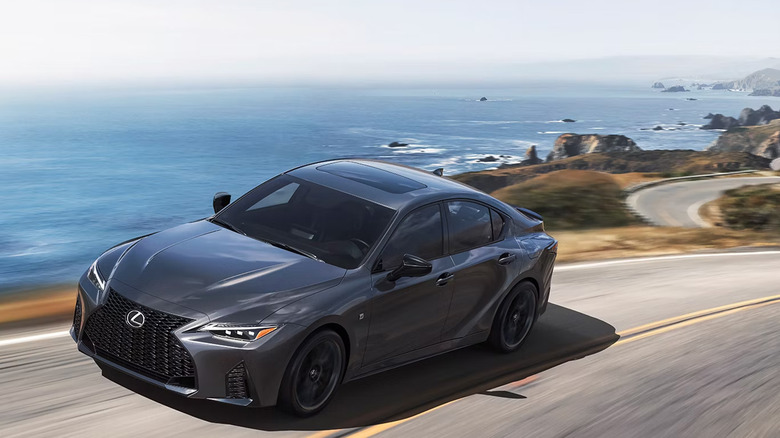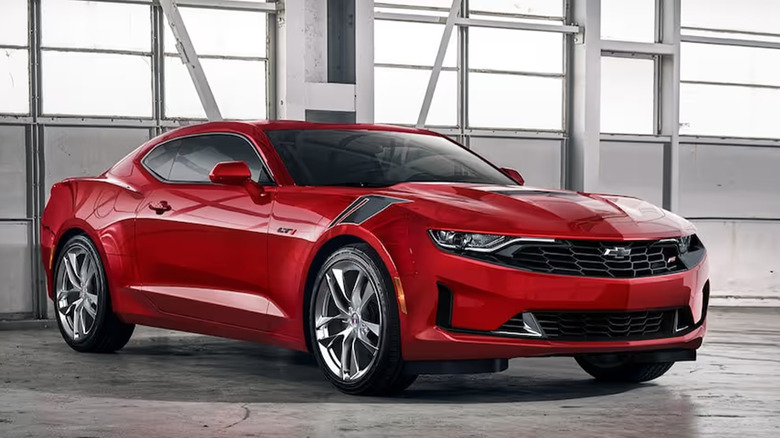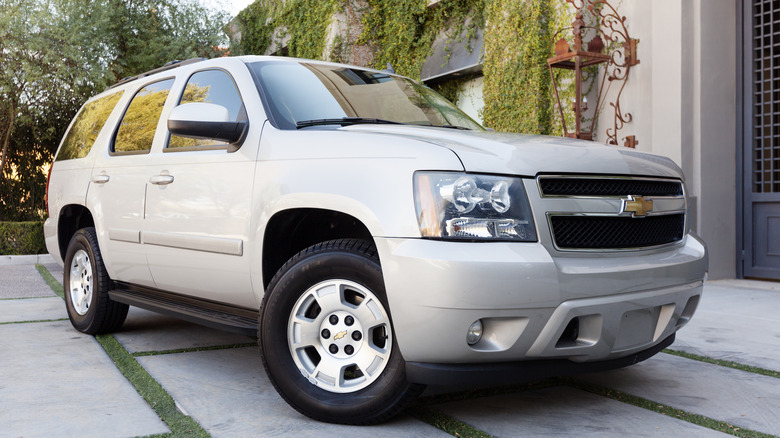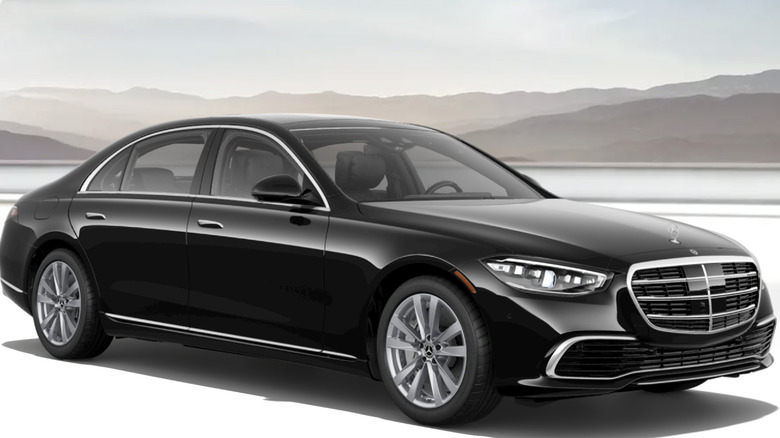5 V8 Cars With Surprisingly Good MPGs
It's no secret that V8 engines get fairly abysmal fuel economy. And it's nothing new, either. Go back to almost any era of the automobile, and you'll see that V8 engines scored pretty low overall, sometimes even less than 10 MPG depending on the car and the driver. There are plenty of reasons for this. V8 engines have higher displacement, which means the engines can take in more air and burn more fuel. This results in higher power, but also more fuel use. A naturally aspirated V8 will almost always use more fuel than a naturally aspirated V6 or V4.
The overwhelming majority of V8s have a combined MPG somewhere in the teens, and even modern version of those engines usually hover around those numbers, for a couple of reasons. For one, combined MPG are calculated slightly in favor of city driving, where EVs reign supreme. At the same time, V8s are among the worst engines for fuel efficiency. However, just because this is usually true doesn't mean it's always true, and a few automakers have had the audacity to make a V8 engine that isn't entirely terrible on gas.
This article's selection consist mostly of newer vehicles, since modern fuel efficiency technologies have made old engines terribly outdated on this matter. Our benchmark for this list is 20 MPG, since it's exceptionally rare to find a V8 with a combined fuel economy rating above that.
2025 Lexus IS 500 F Sport
The Lexus IS 500 F Sport is the first of our five unicorns. Lexus sells a few versions of this model, with prices starting at around $41,000 and three total engine options. The first is a 2.0-liter turbo-four that produces 241 horsepower. Buyers can step up to the 311-horsepower V6, or to the V8, which generates 472 horsepower. Lexus makes this process a little confusing. If you buy the four-cylinder, the car is called the IS 300. Moving up to the V6 makes it an IS 350. Finally, the V8 turns it into the IS 500.
The IS 500 F Sport is rated for 17 MPG in the city and 25 MPG on the highway, which translates to 20 MPG combined. That means Lexus barely squeaked onto this list with the IS 500 F Sport. Per Fuelly, in the real world this model's energy efficiency is higher than 20 MPG, as most drivers' self-reported numbers as better than the estimations. That's a positive sign for potential IS 500 buyers, who can look forward to great fuel economy. Of course, it's not too difficult to decrease gas consumption by being light on the throttle and avoiding stop-and-go traffic. Either way, those are some impressive numbers.
We looked at other Lexus vehicles with V8 engines, and while they came close, they weren't good enough to earn a place on the list. For example, the Lexus LC500 coupe and convertible are both rated for 16 MPG in the city and 24 on the highway, for a combined 18 MPG.
2024 Chevrolet Camaro
I'll be honest, I was not expecting a U.S. car on this list, since many American-made V8 engines fail to live up to the hype, so the Chevy Camaro showing up was a nice surprise. The American automaker actually discontinued the Camaro after the 2024 model, but Chevrolet leadership welcomed new possibilities, adding that "this is not the end of Camaro's story". Reviewers praised the car for its firm but compliant ride, its two excellent engine options, and its overall dynamics and feel. While the 335-horsepower V6 was great in its own right, we'll be talking about the 455-horsepower V8 moving forward.
The V8 model of the Camaro was rated for 16 MPG in the city and 26 on the highway, which just barely crosses over to 20 MPG combined. This result more or less holds true in real-world use, too, with most drivers getting anywhere between 15 MPG and 23 MPG on average. Based on these figures, it seems like it's possible for this vehicle to achieve 20 MPG or higher, even if it can be difficult. However, the Camaro is one of the coolest American pony cars ever built, and people don't generally drive pony cars with fuel efficiency in mind. This means that real-world figures may be skewed by lead-footed drivers having fun.
Should Chevy do as Dodge did with the Charger Daytona and Ford with the Mustang Mach-E, we'll see the Camaro back again someday as an EV. However, Chevrolet doesn't currently have any plans to bring back the nameplate in the near future. We'll have to wait and see what the future holds for the iconic muscle car.
2013 Chevy Tahoe, GMC Yukon, and Cadillac Escalade Hybrid
Our next three selections are all blasts from the past, and they're made by the same automaker, so we grouped them all together. From 2008 to 2013, GM made a Chevy Tahoe, a GMC Yukon, and a Cadillac Escalade that were equipped with a V8 and a hybrid powertrain. There are a few reasons why those vehicles were a failure. They were not exceptionally fast, for one, with the Tahoe being the most noticeable underperformer, with a zero to 60 MPH time of 8.4 seconds. Other reasons included an expensive price tag and, if user reports are accurate, a janky powertrain and common battery issues.
With that said, the fuel economy on all three SUVs was excellent, at least for the standards of this kind of vehicle. The hybrid-equipped V8s are able to churn out 20 MPG in the city and 23 MPG on the highway, combining for 21 MPG. We have the hybrid system to thank for giving these mammoth SUVs such a good city rating. Compared to the non-hybrid variants from the same era, those models' fuel consumption is an average of 4 MPG lower. This was made possible by the hybrid system's ability to drive up to 25 MPG before engaging the gas engine, letting you skip the least fuel-efficient part of owning a V8: traveling at low speeds. GM also used this tech in trucks, which got similar fuel economy numbers.
2024 Mercedes-Benz S580
When it comes to fuel economy on V8 engines, Mercedes-Benz is one of the brands you want to keep your eyes on. Even this very short list of five entries features two of the company's cars. The first of those models is the Mercedes-Benz S580. This is one of the most highly touted luxury sedans on the market, and for good reasons. It packs a ton of tech, has a good engine, and has been hailed as one of the most comfortable vehicles on the road. It also offers two engine options. One is a 442-horsepower turbocharged V6, and the other is a twin-turbo V8 that makes 496 horsepower.
Fuel economy is rarely the point of a V8, but the Mercedes does better than most. Per Edmunds, the V8 model is rated at 21 MPG combined, which is quite good for a V8. Those numbers are attainable in the real world as well, with Edmunds pulling an excellent 23.8 MPG on its test track. Regular drivers seem to be able to match this, with the S580 averaging north of 20 MPG on websites like Fuelly that track real cars to generate realistic averages of gas consumption.
This result isn't terribly surprising, given that the S580 is built for cruising and not speed. Its drivers likely tend to be a little easier on the pedal than those with the aforementioned Camaro. But that doesn't mean that the Mercedes-Benz doesn't have some hustle: if pushed, it can go from zero to 60 MPH in under 4.5 seconds.
2016 Mercedes-Benz AMG SLK 55
The 2016 Mercedes-Benz AMG SLK 55 is pretty much tied with the S580 for the best fuel economy we could find on a V8. That's surprising, given that this car is tuned by AMG, Mercedes-Benz's high-performance arm. Much like the Lexus, the name of this car changes based on which engine it carries. The 2.0-liter turbo-four variant is called the SLK300, the 3.5-liter V6 variant is the SLK350, and the V8 version is the SLK 55. While we made sure that all of our data came from the SLK 55 only, we should state that all models of this car get good fuel economy. The four-cylinder is the most efficient of the three, with 25 MPG in the city and 32 on the highway.
In any case, to the brass tacks. The SLK 55 is rated for 19 MPG in the city and 28 MPG on the highway, which combines for 22 MPG. The combined rating is impressive all on its own, especially since real world figures back it up. However, what's even more remarkable is that Mercedes was able to squeeze out 19 MPG in the city. That's higher than many vehicles' combined fuel economy, which goes to show just how efficient this V8 powertrain is.
This isn't a slow car, either. It can go zero to 60 MPH in 4.5 seconds, putting it in the same ballpark as the S580 listed above while still netting slightly better fuel economy. All told, Mercedes made something special with the SLK 55.
